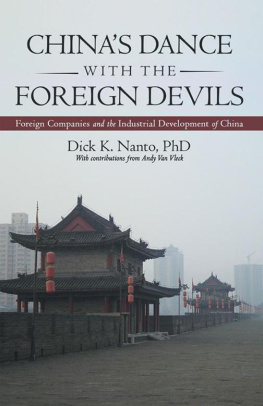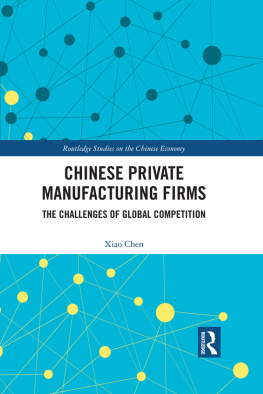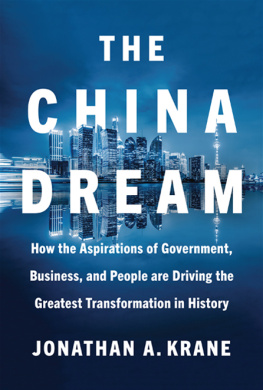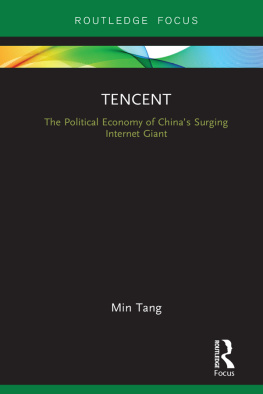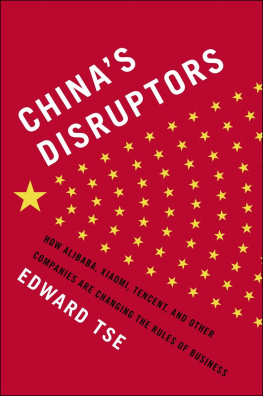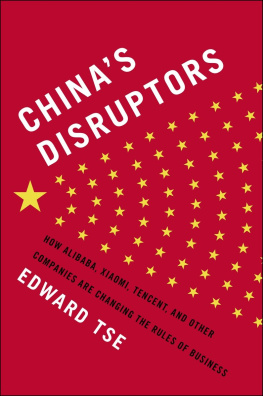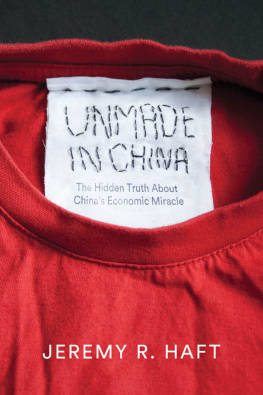To Oscar, Lucas, Lonard, Charlotte & Cleste
To Emily, Cosima & Carl

Contents
Never before in history has such a large country grown economically as fast as China has in the last 30 years. In this process, hundreds of millions of people have been pulled out of poverty. Such a size and rate of change come with particular characteristics. Here are some of them:
More than 650 million Chinese people are connected to the Internet. Most of these are in cities and are remarkably engaged with hand-held devices and internet services.
In recent years, wages have increased 8% per year on average. By and large, China is not a low-cost country any more.
Among the worlds 50 largest firms (by revenue), in 2016, seven are expected to be Chinese, all of them essentially in the oil and banking sectors.
In order to develop domestic manufacturers of cars and planes, China founded a unique breed of firms, the corporate start ups, such as Qoros, for automobiles, and Comac for commercial airplanes.
Such relentless economic development comes with substantial cost, including the environment. Ecological disasters are looming.
In building its transport infrastructure, China is the world of superlatives, building the worlds largest bridge, developing a network of 20,000 km of high-speed train tracks, as well as the worlds highest airport, in Daocheng, Sichuan, at 4,410 meters. In the last ten years, China has invested 8.5% of its GDP in infrastructure each year, as compared with 2.6% for the European Union and 3.9% for India.
In November 2013, the plenum of the communist party announced a continuation of the reform agenda, particularly in the financial and fiscal spheres. Related to this was the bold announcement of a new, large free trade zone in Shanghai.
No one has a comprehensive picture of this fast-changing country. This book intends to inform the debate as to whether or not China will be successful in transforming the manufacturing plant of the world into a major source of innovation.
We document the patterns of this journey, with a particular focus on firms, as they constitute the essential actors of wealth creation. In the following chapters, we present our case for the positive term of the alternative, which, we believe, is not only good for China, but also good for the world.
Geneva and Shanghai, 2015
The focus of this book is on companies, the key agents for generating wealth, moving China towards being a global innovator. As a new world actor of wealth creation, China must behave responsibly. It is hoped that the ethnocentric West will not repeat the grotesque brutality and incompetence of the opium wars in the nineteenth century.
The saga of modern China is quite out of the ordinary because of the scale and speed of change. Upon its creation in 1949, the Peoples Republic of China ( PRC ) built on a legacy of a remarkable culture, crafted over the course of fifty centuries of rich history. Then there was the disastrous rupture with ten years of violence and famine during the Cultural Revolution. However, in the last thirty years or so, the country has taken several hundreds of millions of people out of poverty. This remarkable achievement comes with three substantial liabilities: huge disparities of income, great damage to the environment and potential socio-political instability.
In many ways, China is following the path of Japan and South Korea although it initially relied on massive direct foreign investments, as well as cheap labour. A key step was China joining the World Trade Organisation in 2001. In the recent past, the focus has turned to stronger internal demand, home-grown developments (indigenous innovation) and the internationalizing of Chinese firms.
Reflecting the magnitude of the countrys economy, there is a sort of a Chinese theorem: on the one hand, commodities bought by China go up in price, because the demand is so large. On the other hand, the products sold by China force prices down. China is currently the worlds manufacturing powerhouse, accounting for more than two-thirds of the output in DVD players, childrens toys, and microwave ovens, as well as half of all personal computers/digital cameras.
China, however, is not just a (relatively) low-cost manufacturing country. Much of its manufacturing is moving to lower-cost countries, such as Vietnam. The Chinese economy thus captures only a small fraction of the value added. As a result, it is transitioning towards more value creation. Indeed, Chinas pragmatic and entrepreneurial spirit, massive investment in R&D, compounded by its Confucian tradition and the extensive use of the Internet by its urban population, mean that the country is about to become a major country for innovation. Part of this transition is the shift in the flow of investments. For the first time in 2014, outbound international investments from China were at the same level as foreign inbound investments into China.
The present book looks primarily at companies, but also, of course, at the environment in which they operate. In this momentous transition from made in China to created in China, the following chapters describe the patterns of this remarkable shift.
Chapter 2 evokes Chinas brilliant history of its creative past. In addition to remarkable achievements in the arts, handicrafts and architecture, China is sometimes credited to have invented everything, from printing to gun powder. It did not, however, turn these inventions into sources of wealth or power. The chapter discusses the possible reasons for this absence of commercialising technology. This is in sharp contrast to the strong intent of contemporary China to achieve innovation-led growth, as portrayed by the indicators discussed in the following chapter.
Chapter 3 looks at the metrics, traditionally used as indicators to evaluate how innovation-intensive a country is. The uncertain nature of innovation makes it impossible to have reliable metrics measuring the impact and commercial success of innovation before it happens. Successful innovation is essentially a matter of quality of output, rather than quantity of inputs.
Input measures are used, such as the amount of R&D investments, in the case of technology-intensive innovations. Innovation, however, encompasses much more than those in the technical field.
Going behind the statistics, arguments in the chapter debunk some of the indicators, which are too often taken at face value. As we look at the highly complex process of turning novel ideas into commercial success, the discussion brings corrective elements (e.g. on patent output) taking into account the specifics of the Chinese situation.
Chapter 4 focuses on the key actors of the innovation scene in China: the companies, essential agents for wealth-creation, on the one hand, and the powerful, vertical government apparatus, on the other hand.
A remarkable feature is that the government is strongly and relentlessly committed to innovation. The latter fairly unilaterally defines the rules and the framework conditions, in which the firms operate.
Chapter 5 looks at the countrys framework conditions, which provide a context for innovation to flourish or not. These include the tax code, the legal system, particularly the legislation on intellectual property rights, as well as the infrastructure and the financing of innovation in China. This environment is diverse, as it varies from province to province, continually experimenting and rapidly evolving.
Chapter 6 concentrates on the most crucial element for the success of the innovation process: the human factor. Not specific to China, the single most important ingredient for effective innovation is constituted by the talent and motivation of the staff involved. The Chinese scene presents several specific characteristics in this area, including the role of its large Chinese diaspora.
Next page

